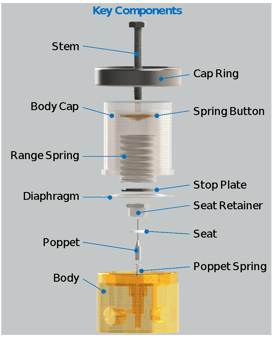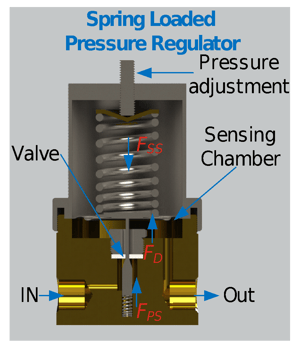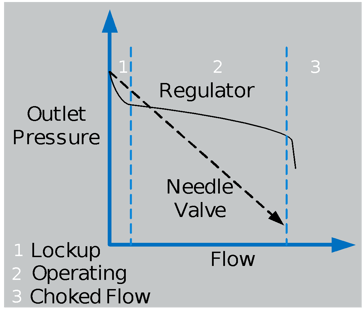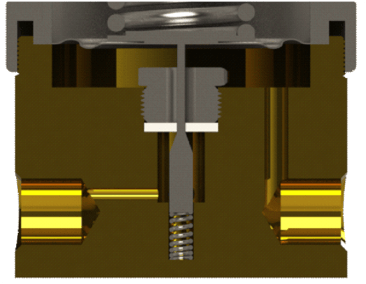Share this
Pressure Regulators Explained: Opening the Box of Mystery
by Jeff Hopkins on 1/30/19 8:45 AM
For many professionals, pressure regulators are a complete mystery and a source of frustration. Let's demystify regulators and help you effectively use them in applications.
Have you wondered “what size regulator do I need to get flow to X at a set pressure of Y?” or “when we changed the flow the outlet pressure of the regulator changed, what gives?"
If so, you're not alone. We receive those questions at least once a week!
To break down pressure regulators—how they work, key principles, and selection tips for optimal fluid system performance—I'll start with a fundamental principle: fluids in the gas phase are compressible and follow the rules of the ideal gas law.
Ideal Gas Law
P*V=n*R*T (Pressure, Volume, number of moles, Gas Constant, Temperature)
- Fluids in the liquid phase are effectively incompressible, so they don’t really change volume when pressure changes
- Pressure is an expression of force over area, and fundamentally related to the number of collisions of the fluid on the walls of its container.
- Flow is the result of a fluid equalizing itself from a higher pressure to a lower pressure. The pressure and cross-sectional area of the tube or other space in which the flow is occurring determines the velocity of the physical molecules.
- Velocity is inversely proportional to pressure, meaning the faster a fluid travels, the more pressure is reduced.
Controlling pressure
If you watched our When Will it Burst? video series, you are probably very aware of the need to control pressure in a fluid system. Perhaps you are reducing the pressure coming out of a bottle of compressed gas, reducing facility gas pressure at the point of use, controlling the discharge of a pump or compressor, or controlling the pressure coming from a bulk gas or steam system as liquid is boiled into gas.


In almost all of these cases, the spring-loaded pressure regulator reigns supreme. There are other types of pressure regulation devices such as dome loaded regulators and electronic pressure controllers, but we'll save those discussions for another time.
A regulator in many ways is a needle valve with a control diaphragm attached to it. A fixed spring pushes the valve closed, while a variable spring pushes on the diaphragm to allow the valve to open. Regulator valve position is determined by the equilibrium state of the three forces in the regulator acting against the valve:
FD – Force of the diaphragm, FSS – Force of the set spring, and FPS – Force of the poppet spring
It is also worth mentioning that atmospheric pressure is also acting against the diaphragm, but for the sake of this discussion it is effectively a constant. In steady state, the sum of diaphragm and poppet spring forces is equal to set spring force:FPS + FD = FSS
Say the pressure regulator is operating in steady state flow at a fixed set point when the downstream flow is increased. The increase in flow results in a decrease in downstream pressure, reducing force on the diaphragm:
FPS + FD ↓≠ FSS
The imbalance in total force on the valve means that the set point spring force is pushing the regulator valve down, opening it. This increases the flow through the regulator until the outlet pressure acts against the diaphragm bringing the forces back into equilibrium. By changing the force of the set point spring, the regulator pressure is effectively adjusted; turning the adjustment screw or knob clockwise tightens the spring, increasing set pressure. Turning it counterclockwise decreases set pressure.
Flow curves
 To properly select a pressure regulator, one of the most important things is to be able to read and understand flow curves. A regulator will change flow to maintain downstream pressure. As downstream pressure goes up or down, the regulator will change its valve position to compensate.
To properly select a pressure regulator, one of the most important things is to be able to read and understand flow curves. A regulator will change flow to maintain downstream pressure. As downstream pressure goes up or down, the regulator will change its valve position to compensate.
Since a regulator has mechanical limitations, it has droop associated with its operation. That means the regulator will never stay at the same pressure as flow changes throughout the range. A regulator can dampen this effect only by changing its valve position. Contrast this with a non-regulated valve like a needle valve and the effect on outlet pressure is far more dramatic.
"To properly select a pressure regulator, one of the most important things is to be able to read and understand flow curves."
For pressure regulators, the flow curve typically consists of three parts: lockup (also called seat load drop), operating range, and choked flow. When too much pressure builds up, the regulator will close off the inlet, or lock it up. A dead giveaway of lockup is chattering or pulsating sounds coming from the regulator. When pressure drops too far, the regulator valve is fully open and the regulator is effectively no longer operating. In this condition increasing flow only means greater pressure drop from the regulator.
The ideal part of a regulator’s operating curve is the "Goldilocks" zone, right in the middle of the operating range where the valve has the most control.
Turndown
 An incredibly important and commonly overlooked factor in the function of a pressure regulator is the turndown ratio. Effectively it's the ratio of inlet pressure to outlet pressure. The higher the ratio, the larger the range of flow your regulator will have. This effect is primarily driven by the expansion of the gas across the regulator valve. (For regulators operating in a liquid stream, this is pretty much irrelevant.)
An incredibly important and commonly overlooked factor in the function of a pressure regulator is the turndown ratio. Effectively it's the ratio of inlet pressure to outlet pressure. The higher the ratio, the larger the range of flow your regulator will have. This effect is primarily driven by the expansion of the gas across the regulator valve. (For regulators operating in a liquid stream, this is pretty much irrelevant.)
The greater the expansion of gas across the regulator valve, the less the regulator’s valve has to move to change outlet pressure. Most pressure regulators don’t have a significant amount of valve movement to reach the end of travel. Generally, though not universally, it’s best to operate with at least a 10:1 turndown ratio, especially when operating at pressures under 100 PSIG. If you’re unable to have a 10:1 ratio, make sure you identify a regulator capable of operating with an extremely low turndown.
Check your references
There are far more factors that can influence the performance of a pressure regulator, including the Joule-Thompson effect, the Supply Pressure Effect, density or specific gravity of the media inside, and many more not mentioned here. Swagelok has amassed a large amount of performance data for our pressure regulators and detailed charts are readily available.
If you have our eDTR software, navigate to the “Technical” link under the “Regulators” link at the end. If you look up Pressure Regulator Flow Curves Technical Bulletin (MS-06-114), you’ll find 216 pages of operational explanations and flow curves on both gas and liquid. There are a significant number of flow curves in this reference that are not in the regulator catalog. If you don’t have our eDTR software, you can request one or you can access the tech bulletin through the Regulators Technical section of our eCatalog or you can download it directly from our flow curves landing page.
If you have ever looked at our regulator catalog you likely noticed that the standard K-series regulator has a staggering 16-digit configurable part number. When combined with all the different types of regulators in the catalog, you wind up with about 10 million possible combinations. The bad news is that we can stock only a small fraction of those combinations. The good news is that there is an 80 percent chance we will have the range of pressure regulator you need in stock.
Need your regulator pre-assembled and ready to install? Check out our Swagelok regulator assemblies.
Webinars on this topic:
Share this
- Archive (465)
- Assembly Services (207)
- About (100)
- Seal Support Systems (96)
- Best Practices (88)
- Training Services (74)
- Fittings (51)
- Semiconductor Applications (49)
- Hoses and Flexible Tubing (47)
- Regulators (44)
- Tubing (42)
- Grab Sampling Systems (32)
- Sampling Systems (32)
- Gas Systems (30)
- Services (30)
- Downloads (29)
- Valves (24)
- Application Support (18)
- Orbital Welding (17)
- Case Studies (13)
- Steam Systems (13)
- Frequently Asked Questions (12)
- Tools (12)
- Measurement Devices (7)
- Subsystems (6)
- Thermal Management (6)
- September 2023 (1)
- August 2023 (2)
- June 2023 (1)
- March 2023 (3)
- February 2023 (3)
- January 2023 (4)
- December 2022 (4)
- November 2022 (4)
- October 2022 (4)
- September 2022 (1)
- August 2022 (3)
- July 2022 (2)
- June 2022 (4)
- May 2022 (1)
- April 2022 (2)
- March 2022 (1)
- February 2022 (2)
- January 2022 (3)
- December 2021 (1)
- November 2021 (6)
- October 2021 (6)
- September 2021 (8)
- August 2021 (4)
- July 2021 (3)
- June 2021 (6)
- May 2021 (6)
- April 2021 (7)
- March 2021 (5)
- February 2021 (4)
- January 2021 (6)
- December 2020 (5)
- November 2020 (6)
- October 2020 (6)
- September 2020 (8)
- August 2020 (7)
- July 2020 (8)
- June 2020 (8)
- May 2020 (6)
- April 2020 (9)
- March 2020 (7)
- February 2020 (10)
- January 2020 (21)
- December 2019 (23)
- November 2019 (21)
- October 2019 (22)
- September 2019 (21)
- August 2019 (22)
- July 2019 (23)
- June 2019 (20)
- May 2019 (23)
- April 2019 (22)
- March 2019 (21)
- February 2019 (20)
- January 2019 (21)
- December 2018 (14)
- November 2018 (19)
- October 2018 (23)
- September 2018 (17)
- August 2018 (29)
- July 2018 (11)
- June 2018 (6)
- May 2018 (5)
- April 2018 (4)
- March 2018 (5)
- February 2018 (3)
- January 2018 (3)
- December 2017 (2)
- November 2017 (4)
- October 2017 (3)
- September 2017 (2)
- August 2017 (6)
- July 2017 (4)
- June 2017 (4)
- May 2017 (4)
- April 2017 (3)
- March 2017 (4)
- February 2017 (3)
- January 2017 (3)
- December 2016 (3)
- November 2016 (3)
- October 2016 (3)
- September 2016 (5)
- August 2016 (5)
- July 2016 (4)
- June 2016 (5)
- May 2016 (3)
- April 2016 (4)
- March 2016 (5)
- February 2016 (11)
- January 2016 (1)
- December 2015 (3)
- November 2015 (4)
- October 2015 (3)
- September 2015 (4)
- August 2015 (4)
- July 2015 (8)
- June 2015 (5)
- May 2015 (3)
- April 2015 (4)
- March 2015 (4)
- February 2015 (3)
- January 2015 (4)
- December 2014 (2)
- November 2014 (3)
- October 2014 (4)
- September 2014 (4)
- August 2014 (4)
- July 2014 (5)
- June 2014 (4)
- May 2014 (4)
- April 2014 (5)
- March 2014 (4)
- February 2014 (3)
- January 2014 (4)
- December 2013 (5)
- November 2013 (3)
- October 2013 (4)
- September 2013 (3)
- August 2013 (5)
- July 2013 (5)
- June 2013 (5)
- May 2013 (3)
- April 2013 (6)
- March 2013 (4)
- February 2013 (4)
- January 2013 (8)
- December 2012 (4)
- November 2012 (6)
- October 2012 (6)
- September 2012 (4)
- August 2012 (4)
- July 2012 (4)
- June 2012 (4)

.webp?width=210&height=70&name=StickyLogo%20(5).webp)
